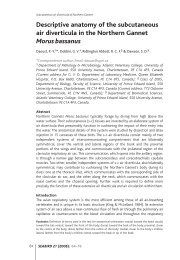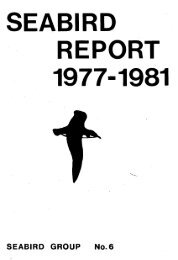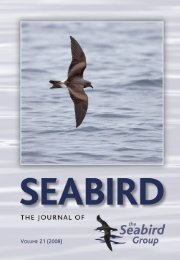You also want an ePaper? Increase the reach of your titles
YUMPU automatically turns print PDFs into web optimized ePapers that Google loves.
204 T. KRÜGER & S. GARTHE Atlantic <strong>Seabird</strong>s 3(4)<br />
level using radar (Williams & Williams 1990; Berthold 2000). For a long time<br />
the intensity of low-level migratory movements over the sea generally were<br />
thought - aside from the moult migration of Shelduck Tadorna tadorna- to be of<br />
minor importance (cf. Jellmann 1979, 1987, 1989). Major improvements in<br />
radar technology now enable exact measurements of flight altitudes (e.g.<br />
Dirksen et al. 1996, 1998). However, such studies have been carried out so far<br />
only at selected locations, usually to inform environmental issues such as wind<br />
energy utilization.<br />
<strong>The</strong> purpose of the study described here was to examine the flight<br />
altitudes of the most common coastal birds and seabirds by field observations of<br />
visible migration and to identify the influence of the meteorological parameters<br />
wind direction and speed.<br />
METHODS<br />
Visible migration of coastal birds and seabirds was studied on 52 days between<br />
1 September and 15 <strong>No</strong>vember 1999 on Wangerooge Island, Germany.<br />
Wangerooge is located in the southern <strong>No</strong>rth Sea (German Bight; 53°47'N<br />
07°54'E) and constitutes the easternmost of the East Frisian islands.<br />
Observations followed common sea watching methods (Camphuysen & van<br />
Dijk 1983) using a telescope (Swarovski, AT 30x80 HD). We excluded all<br />
common gull species from the observations (Larus argentatus, L. fuscus, L.<br />
marinus, L. canus, L. ridibundus) because it was impossible to distinguish<br />
between true migration and frequent local movements between resting and<br />
feeding sites. <strong>The</strong> method of sea watching has been proved suitable for<br />
describing and analysing migratory behaviour (e.g. phenology, influence of<br />
wind) of birds along the coast and at sea (e.g. Camphuysen & van Dijk 1983,<br />
Platteeuw et al. 1994). It is not the purpose of this study to assess all birds flying<br />
during day and night, which could be done much more comprehensively by<br />
radar studies.<br />
In order to study whether wind direction and wind speed influence<br />
directly the flight altitude of migrating birds, all individuals passing<br />
Wangerooge were allocated to one of several pre-arranged flight levels. Because<br />
the estimation of flight altitude is difficult in general and because "observers<br />
nearly always overestimate the height of migrating birds" (Thienemann 1931,<br />
see also Gätke 1900, Lucanus 1923), a simple but accurate schema had to be<br />
devised (Fig. 1):<br />
• Birds flying low over the water were allocated to the lowest level (low). <strong>The</strong> upper<br />
limit of this level was about 1.5 m. In light winds and relatively calm seas it was<br />
easy to identify this level. In these conditions, the birds often flew so low over the








